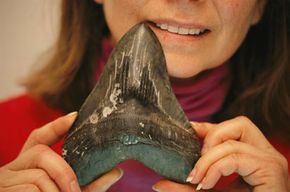How to Find a Shark Tooth
Sure, you can go online and buy a tooth from another collector -- and many enthusiasts do just that. But the most fun and rewarding way to do it is to get out into the water and find one with your bare hands. It can be as relaxing as a walk on the beach. In fact, there's not much more to it than that.
Low tide is the best time to find these sharp fossils. The water is calmer and clearer at low tide, giving you better visibility. The receding waters also expose some of the best areas to look for teeth. These areas are the drop-offs that occur just along the shore line -- where the surf goes back into sea, there's commonly a 6 to 12-inch drop in the sand level, called a "wash-in." Rocky sediment collects here and you can usually find a large amount of sea rocks, shells and, if you're lucky, shark teeth. Morning is a good time to search, if for no other reason than the fact that there are fewer people around to contend with.
Advertisement
Teeth can also be found on the beach itself, or even far away from the water. In fact, the inland town of Bakersfield, Calif., is known for producing some of the largest megalodon teeth ever found. After all, it used to be underwater, as did the entire state of Florida. Another tip when searching along the shoreline is to concentrate on areas where the sand is darker. It's also a good idea to head out after a storm. Ocean storms typically bring in all kinds of debris to deposit on the beach, including teeth.
You might want to carry along a small shovel, gardening pick and a sieve to sift through the sand -- and don't forget a bag to carry your booty. Once you have your teeth, you can check online or get a book to help you identify what kind of shark it came from. Then it's up to you exactly what you do with it. Avid collectors typically display the teeth in framed boxes, and many people include display cards indicating the species and the date and location where the tooth was found. Other people sell or trade with other collectors if the tooth is valuable. You can also make the tooth into jewelry if that's your thing -- shark tooth necklaces are a hot commodity among the Jimmy Buffett crowd.
Related Articles
- How Sharks Work
- How Fossils Work
- How Shark Attacks Work
- How Whales Work
- Do whales and dolphins sleep?
- If water is made up of hydrogen and oxygen, why can't we breathe underwater?
- How Scuba Works
- How the Georgia Aquarium Works
- What causes "the bends"?
- Is it harmful to breathe 100-percent oxygen?
- Why do my ears pop when I dive in the deep end of the pool?
- How much water is there on earth?
- How do fish rise and sink in the water?
- Shark Quiz
- Tiger Shark Quiz
- Great White Quiz
- Shark Attack Quiz
More Great Links
Sources
- "A 'Quick & Dirty' Guide to Fossil and Recent Shark Teeth." elasmo-research.org, 2008. http://www.elasmo-research.org/education/evolution/guide.htm
- "Shark School." San Diego Natural History Museum. sdhnm.org. http://www.sdnhm.org/kids/sharks/faq.html#teeth
- "Shark Teeth from Around the World!" sharteeth.com, 2008. http://www.sharkteeth.com/site/index.cfm?action=what_is
- "Sharks Teeth." veniceflorida.com.http://www.veniceflorida.com/shark.htm
- Baldwin, Mike. "Hunting for fossil sharks' teeth." memphisgeology.org, June 21, 2000. http://www.memphisgeology.org/p_sharks_teeth.htm
- Garcia, Frank A. and Miller, Donald S. "Discovering Fossils." Stockpole Books, 1998.
- Howard, Willie. "Diving for shark teeth and bites of history." Cyber Diver News Network, November 11, 2004. http://www.cdnn.info/eco/e041111/e041111.html
- Jordan, Kyle. "Day tripping with Kyle Jordan: Shark Tooth Capital of the World." winknews.com, April 11, 2008. http://www.winknews.com/features/daytripping/17550249.html
